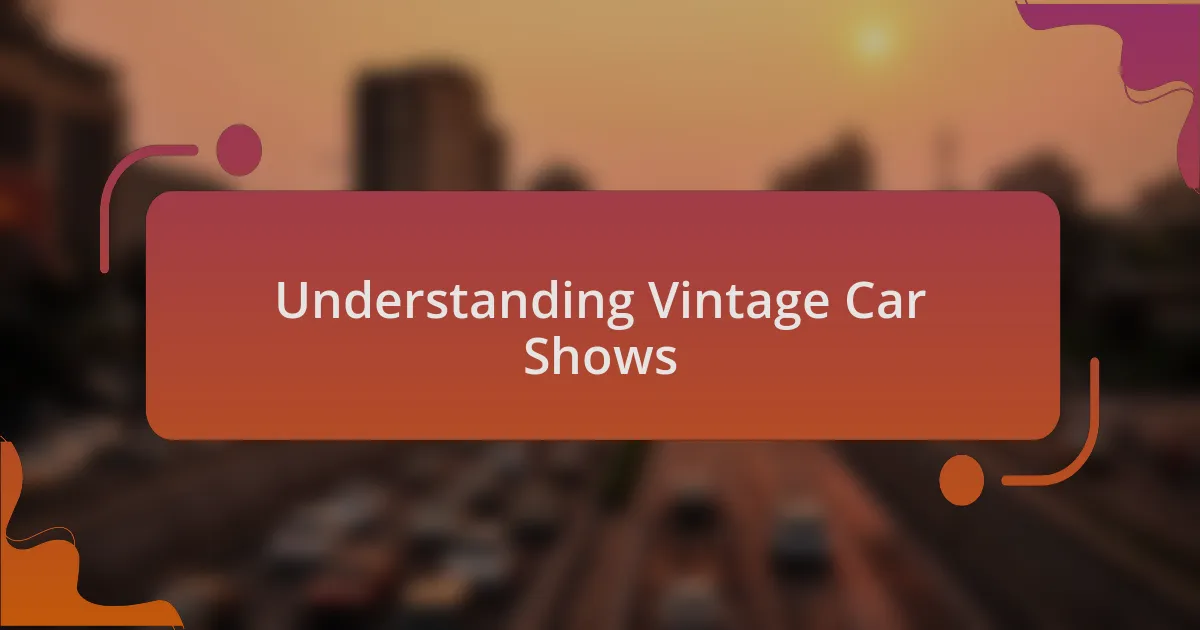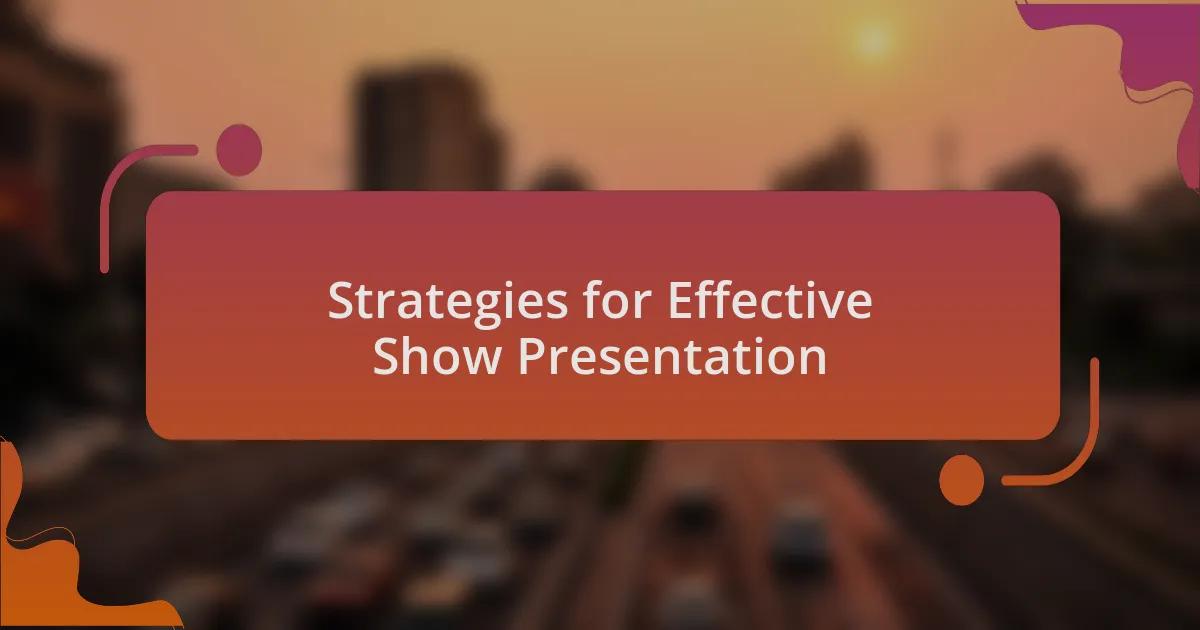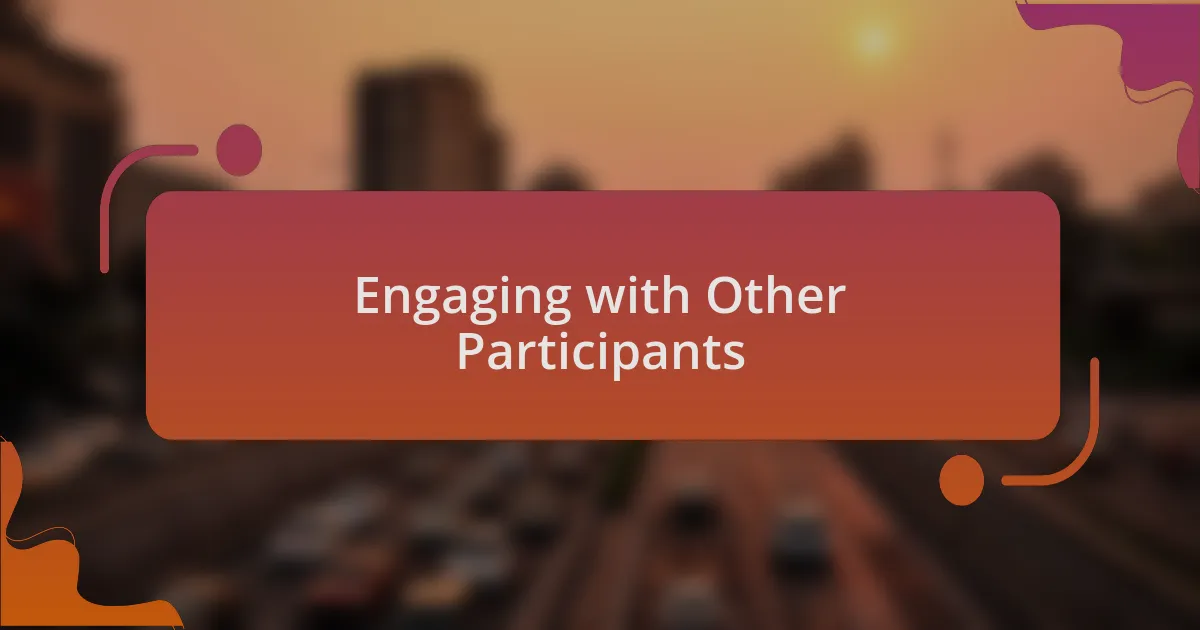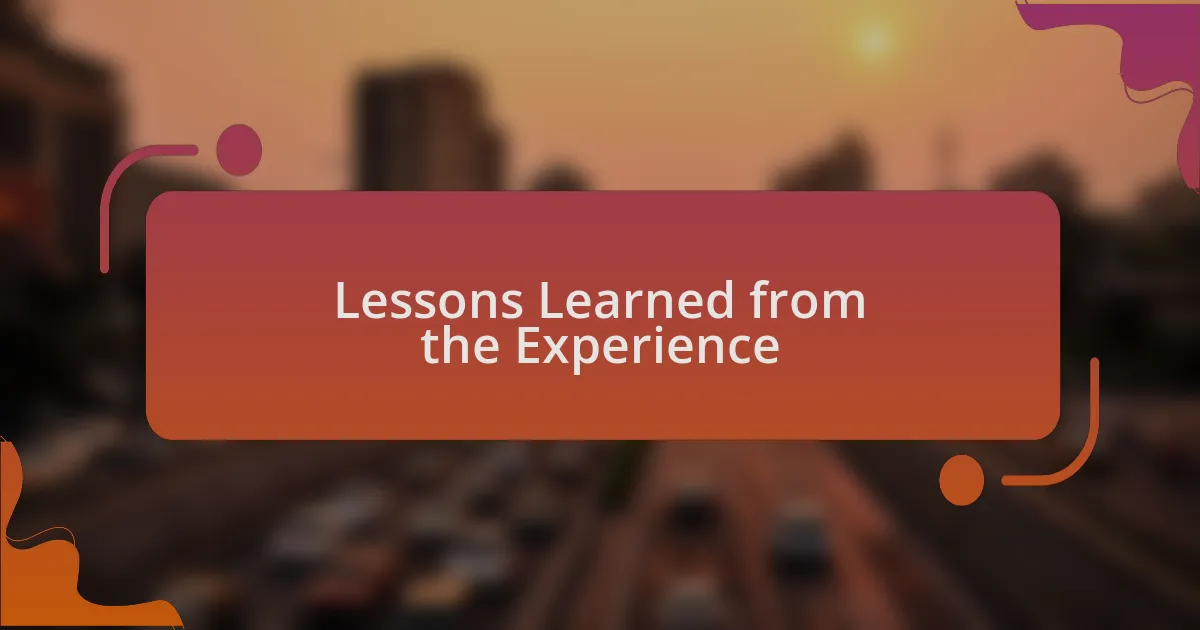Key takeaways:
- Vintage car shows celebrate history, craftsmanship, and community among enthusiasts, creating opportunities for connections and shared stories.
- Handling competition positively fosters growth, encourages collaboration, and enhances the vintage car culture through mutual respect and support.
- Preparation and presentation are crucial for success; attention to detail and authentic storytelling can significantly impact the overall impression of a vehicle.
- Engaging with other participants and sharing experiences enriches the community, transforming rivalry into camaraderie, and enhancing everyone’s passion for vintage cars.

Understanding Vintage Car Shows
Understanding vintage car shows goes beyond just showcasing beautiful automobiles; it’s a celebration of history and craftsmanship. I remember my first show vividly—the smell of polished chrome and the sound of engines revving created an electric atmosphere. Have you ever felt that sense of awe when seeing a classic car up close, knowing the stories it could tell?
At these events, there’s a palpable camaraderie among enthusiasts. It’s incredible how someone might approach me, drawn by a mutual love for a vintage Ford Mustang, sparking a conversation that could last for hours. Each car at the show not only represents its era but also brings together a community of passionate individuals who cherish these machines like old friends.
I’ve always found vintage car shows to be a unique blend of competition and appreciation. As I wandered through rows of immaculately restored vehicles, I couldn’t help but ponder: what makes one car stand out over another? Is it the gleaming paint job or the meticulous attention to detail? Each vehicle tells a story of dedication and love, making these events a treasure trove of inspiration for every car enthusiast.

Importance of Handling Competition
Handling competition at vintage car shows is crucial for several reasons. For one, it helps foster a healthy spirit of rivalry that can push collectors and restorers to improve their craft. I remember competing with a fellow enthusiast a few years ago; seeing his attention to detail motivated me to take my restoration skills to the next level. Isn’t it fascinating how a bit of competition can fuel growth and innovation?
Moreover, how we handle competition can reveal a lot about our character. I’ve witnessed many passionate car owners banding together, sharing tips and experiences even while vying for the same coveted trophies. This kind of mutual respect transforms competition from a rivalry into a learning experience, enriching our collective knowledge and love for vintage cars.
It’s also essential to understand that managing competition isn’t just about personal gain. It can cultivate an inclusive environment that welcomes newcomers. When I see a charismatic rookie at a show, eager yet nervous, I feel compelled to share my experiences. After all, the beauty of vintage car culture lies not only in our vehicles but also in the friendships we build along the way.

Prepping Your Vintage Car
When it comes to prepping your vintage car for a show, attention to detail is absolutely vital. I often start by meticulously cleaning every inch of the exterior and inspecting the chrome work; there’s something incredibly satisfying about seeing that shining finish. Do you remember the feeling of presenting something you’ve poured your heart into? It’s exhilarating.
Next, I delve into engine maintenance, a task that always grounds me. I once spent hours ensuring the engine bay was as polished as the body; I even replaced a few old hoses for good measure. That level of dedication makes a tangible difference when I finally start the engine and hear that sweet, smooth purr. It’s little things like this that can set you apart from the competition, right?
Lastly, I always take the time to review the car’s history and prepare a story to share with judges and fellow enthusiasts. I believe that showcasing the journey of my vehicle not only adds depth but also elevates its appeal. Have you thought about how a good story can turn heads just as much as a flawless paint job? Engaging others with the unique narrative behind each car adds a personal touch that every lover of vintage cars can appreciate.

Strategies for Effective Show Presentation
When I think about effective show presentation, I always emphasize the importance of creating a visually striking display. I remember once using vintage-themed props and custom backdrops that complemented my car’s era beautifully. It transformed the booth from just another spot in the show to a mini-museum, attracting attention and sparking conversations. Have you ever considered how ambiance can amplify the story of your vehicle?
Engagement with the audience is another critical strategy I prioritize. During one show, I made a point to walk around my booth, interacting with visitors, answering questions, and sharing anecdotes. It wasn’t just about showcasing the car; it was about connecting with fellow enthusiasts. There’s something magical about seeing their eyes light up when you share a personal story. How do you think sharing experiences can deepen connections at these events?
Lastly, I always prepare for the unexpected. One time, my car wouldn’t start right before judging. Instead of panicking, I turned it into an opportunity—showing my troubleshooting skills while connecting with bystanders. It’s moments like these that remind me: it’s not just about winning trophies but also about sharing the passion and resilience that comes with being a vintage car enthusiast. How would you handle a surprise like that?

Engaging with Other Participants
Engaging with other participants at shows is an essential aspect of the vintage car community. I vividly recall a moment when I struck up a conversation with another exhibitor who had restored a model I dreamed of owning. We spent hours discussing each other’s techniques and tips, which not only expanded my knowledge but also built a meaningful connection. Have you ever found mutual respect in a shared enthusiasm?
Beyond casual chats, I believe it’s important to support fellow participants, especially in competitive settings. I once cheered on a competitor who had a breathtaking restoration, and to my surprise, he reciprocated by endorsing my work to the crowd. It created a warm atmosphere where camaraderie overshadowed rivalry, inviting everyone to celebrate our shared passion. How do you handle competition while fostering collaboration?
During one show, we even organized an informal meet-up for all participants to share our stories and experiences over lunch. This gathering was more than just a social event; it allowed us to exchange ideas and learn from one another in a relaxed setting. I left feeling inspired and uplifted by the stories of resilience and dedication from my peers. Isn’t it fascinating how community can thrive even amidst competition?

Lessons Learned from the Experience
Throughout my experiences at shows, I learned that preparation is key. I remember one event where I underestimated the impact of presentation. Despite having an exceptional vehicle, my display lacked flair compared to others. This realization hit hard, motivating me to enhance my setup for future shows. Have you ever felt unprepared and realized it cost you?
Another takeaway was the importance of staying true to my vision. There were times I was tempted to follow trends and mimic others, but that diluted my authenticity. In one instance, I decided to stick with my original design for a restoration, and it resonated with the audience more than I expected. Isn’t it liberating to embrace what makes your work unique?
Lastly, competition taught me invaluable lessons about resilience and grace. In a particularly competitive show, I faced tough feedback, but instead of being disheartened, I viewed it as constructive criticism. This shift in perspective allowed me to grow and improve, reminding me that setbacks can fuel growth. Have you ever turned disappointment into motivation?

Tips for Future Competitions
To truly shine in future competitions, I suggest focusing on the details of your presentation. For instance, during one competition, I noticed that even small additions like period-correct signage and props significantly enhanced the storytelling of my car’s history. Have you considered how these extras might elevate your vehicle’s appeal?
Another essential tip is to connect with fellow enthusiasts ahead of time. I remember reaching out to peers before a big show and sharing insights about the event. This camaraderie not only eased my nerves but also helped me gauge the competition. Isn’t it helpful to have allies in a fiercely competitive atmosphere?
Lastly, practice your pitch. I’ve discovered that articulating the story behind your vehicle can captivate judges and attendees. During one event, while discussing my car’s restoration, I saw genuine interest spark in the audience. Have you practiced your narrative enough to convey the passion behind your work?